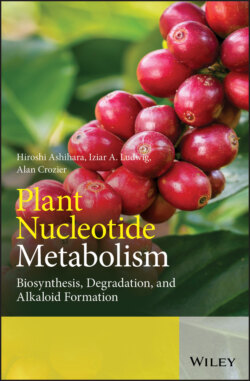Читать книгу Plant Nucleotide Metabolism - Hiroshi Ashihara - Страница 42
3.4.2 Substrate-Level ATP Synthesis
ОглавлениеSubstrate-level phosphorylation of ADP is performed by the direct transfer of a phosphoryl group to ADP from another phosphorylated compound (Table 3.1). In the TCA cycle in plants, substrate-level phosphorylation occurs mainly in the cytosol or chloroplasts during glycolysis and in mitochondria.
Substrate-level phosphorylation in glycolysis occurs via two steps, 7 and 10, in Figure 3.3. After the conversion of glyceraldehyde-3-phosphate to glycerate-1,3-bisphosphate, catalysed by glyceraldehyde-3-phosphate dehydrogenase using Pi and NAD+ (step 6), ATP is formed by the dephosphorylation of glycerate-1,3-bisphosphate (step 7). The second substrate-level phosphorylation is catalysed by pyruvate kinase (step 10) and ATP is produced from the phosphate group of phosphoenolpyruvate. The hexose molecule is split into two three-carbon molecules, via an aldolase reaction (step 4). Hexose is converted to fructose-1,6-bisphosphate by hexokinase (step 1) and phosphofructokinase (step 3a), in the process consuming 2 mol and producing 4 mol of ATP in steps 7 and 10. Thus, there is net production of 2 mol of ATP. The ATP-consuming and ATP-producing reactions of glycolysis are illustrated in Figure 3.4. If the conversion is performed by hexokinase (step 1) and pyrophosphate (PPi)-dependent phosphofructokinase (step 3b), net production of ATP is 3 mol from 1 mol of hexose. Two mol of NADH produced by glycolysis can be used in oxidative phosphorylation in mitochondria to generate more ATP (Zeeman 2015).
A further substrate-level phosphorylation occurs in the TCA cycle. In the matrix of the mitochondria, a substrate-level phosphorylation occurs at the succinate-CoA ligase reaction step (step 6 in Fig. 3.2). In contrast to animals, in plants ATP-specific succinyl-CoA synthetase (EC 6.2.1.5), but not GTP-succinyl-CoA synthetase (EC 6.2.1.4), acts as an enzyme in the TCA cycle (see Figure 3.4). This enzyme produces ATP from ADP accompanied by degradation of succinyl-CoA (Table 3.1 and Figure 3.4c). For further details of this topic, readers can refer to comprehensive plant biochemistry text books such as Bowsher et al. (2012) and Buchanan et al. (2015).
